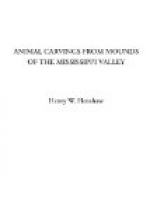It is a little perplexing to find at the outset that Squier and Davis, not content with one toucan, have figured three, and these differing from each other so widely as to be referable, according to modern ornithological ideas, to very distinct orders.
[Illustration: Fig. 14.—Toucan of Squier and Davis.]
The first allusion to the toucan in the Monuments of the Mississippi Valley is found on page 194, where the authors guardedly remark of a bird’s head in terra cotta (Fig. 79), “It represents the head of a bird, somewhat resembling the toucan, and is executed with much spirit.”
This head is vaguely suggestive of a young eagle, the proportions of the bill of which, until of some age, are considerably distorted. The position of the nostrils, however, and the contour of the mandibles, together with the position of the eyes, show clearly enough that it is a likeness of no bird known to ornithology. It is enough for our present purpose to say that in no particular does it bear any conceivable resemblance to the toucan.
Of the second supposed toucan (Ancient Monuments, p. 260, Fig. 169) here illustrated, the authors remark:
The engraving very well represents the original, which is delicately carved from a compact limestone. It is supposed to represent the toucan—a tropical bird, and one not known to exist anywhere within the limits of the United States. If we are not mistaken in supposing it to represent this bird, the remarks made respecting the sculptures of the manitus will here apply with double force.
[Illustration: Fig. 15.—Toucan of Squier and Davis.]
This sculpture is fortunately easy of identification. Among several ornithologists, whose opinions have been asked, not a dissenting voice has been heard. The bird is a common crow or a raven, and is one of the most happily executed of the avian sculptures, the nasal feathers, which are plainly shown, and the general contour of the bill being truly corvine. It would probably be practically impossible to distinguish a rude sculpture of a raven from that of a crow, owing to the general resemblance of the two. The proportions of the head here shown are, however, those of the crow, and the question of habitat renders it vastly more likely that the crow was known to the Mound-Builders of Ohio than that the raven was. What possible suggestion of a toucan is to be found in this head it is not easy to see.
Turning to page 266 (Fig. 178) another and very different bird is held up to view as a toucan.
[Illustration: Fig. 16.—Toucan of Squier and Davis.]
Squier and Davis remark of this sculpture:




